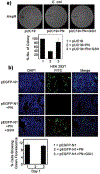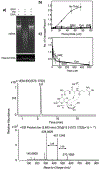Protective Role of Glutathione against Peroxynitrite-Mediated DNA Damage During Acute Inflammation
- PMID: 32894672
- PMCID: PMC9297005
- DOI: 10.1021/acs.chemrestox.0c00299
Protective Role of Glutathione against Peroxynitrite-Mediated DNA Damage During Acute Inflammation
Abstract
Inflammation is an immune response to protect against various types of infections. When unchecked, acute inflammation can be life-threatening, as seen with the current coronavirus pandemic. Strong oxidants, such as peroxynitrite produced by immune cells, are major mediators of the inflammation-associated pathogenesis. Cellular thiols play important roles in mitigating inflammation-associated macromolecular damage including DNA. Herein, we have demonstrated a role of glutathione (GSH) and other thiols in neutralizing the effect of peroxynitrite-mediated DNA damage through stable GSH-DNA adduct formation. Our observation supports the use of thiol supplements as a potential therapeutic strategy against severe COVID-19 cases and a Phase II (NCT04374461) open-label clinical trial launched in early May 2020 by the Memorial Sloan Kettering Cancer Center.
Conflict of interest statement
The authors declare no competing financial interest.
Figures






Similar articles
-
Selenium redox cycling in the protective effects of organoselenides against oxidant-induced DNA damage.J Am Chem Soc. 2004 Mar 3;126(8):2409-13. doi: 10.1021/ja037294j. J Am Chem Soc. 2004. PMID: 14982447
-
Inflammation resolution: a dual-pronged approach to averting cytokine storms in COVID-19?Cancer Metastasis Rev. 2020 Jun;39(2):337-340. doi: 10.1007/s10555-020-09889-4. Cancer Metastasis Rev. 2020. PMID: 32385712 Free PMC article.
-
Targeting the SphK-S1P-SIPR Pathway as a Potential Therapeutic Approach for COVID-19.Int J Mol Sci. 2020 Sep 29;21(19):7189. doi: 10.3390/ijms21197189. Int J Mol Sci. 2020. PMID: 33003377 Free PMC article. Review.
-
Acute inflammation and pathogenesis of SARS-CoV-2 infection: Cannabidiol as a potential anti-inflammatory treatment?Cytokine Growth Factor Rev. 2020 Jun;53:63-65. doi: 10.1016/j.cytogfr.2020.05.008. Epub 2020 May 20. Cytokine Growth Factor Rev. 2020. PMID: 32467020 Free PMC article. Review. No abstract available.
-
A potential protective role of losartan against coronavirus-induced lung damage.Infect Control Hosp Epidemiol. 2020 Jun;41(6):752-753. doi: 10.1017/ice.2020.80. Infect Control Hosp Epidemiol. 2020. PMID: 32248854 Free PMC article. No abstract available.
Cited by
-
Association of Low Molecular Weight Plasma Aminothiols with the Severity of Coronavirus Disease 2019.Oxid Med Cell Longev. 2021 Sep 18;2021:9221693. doi: 10.1155/2021/9221693. eCollection 2021. Oxid Med Cell Longev. 2021. PMID: 34557267 Free PMC article.
-
Reconsidering the Chemical Nature of Strand Breaks Derived from Abasic Sites in Cellular DNA: Evidence for 3'-Glutathionylation.J Am Chem Soc. 2022 Jun 15;144(23):10471-10482. doi: 10.1021/jacs.2c02703. Epub 2022 May 25. J Am Chem Soc. 2022. PMID: 35612610 Free PMC article.
-
Evaluation of the efficacy and safety of oral N-acetylcysteine in patients with COVID-19 receiving the routine antiviral and hydroxychloroquine protocol: A randomized controlled clinical trial.Immun Inflamm Dis. 2023 Nov;11(11):e1083. doi: 10.1002/iid3.1083. Immun Inflamm Dis. 2023. PMID: 38018602 Free PMC article.
-
Visualization of DNA Damage and Protection by Atomic Force Microscopy in Liquid.Int J Mol Sci. 2022 Apr 15;23(8):4388. doi: 10.3390/ijms23084388. Int J Mol Sci. 2022. PMID: 35457204 Free PMC article.
-
Molecular Mechanisms Related to Responses to Oxidative Stress and Antioxidative Therapies in COVID-19: A Systematic Review.Antioxidants (Basel). 2022 Aug 19;11(8):1609. doi: 10.3390/antiox11081609. Antioxidants (Basel). 2022. PMID: 36009328 Free PMC article. Review.
References
-
- Fujiwara N, and Kobayashi K (2005) Macrophages in inflammation. Curr. Drug Targets: Inflammation Allergy 4, 281–286. - PubMed
-
- Medzhitov R (2008) Origin and physiological roles of inflammation. Nature 454, 428–435. - PubMed
-
- Medzhitov R (2010) Inflammation 2010: new adventures of an old flame. Cell 140, 771–776. - PubMed
-
- Weiss U (2008) Inflammation. Nature 454, 427. - PubMed
Publication types
MeSH terms
Substances
Grants and funding
LinkOut - more resources
Full Text Sources

